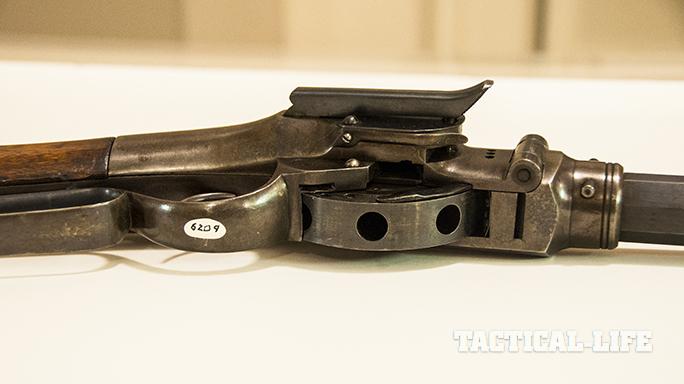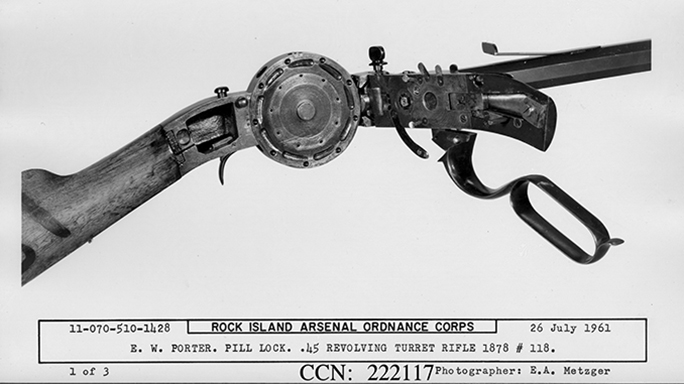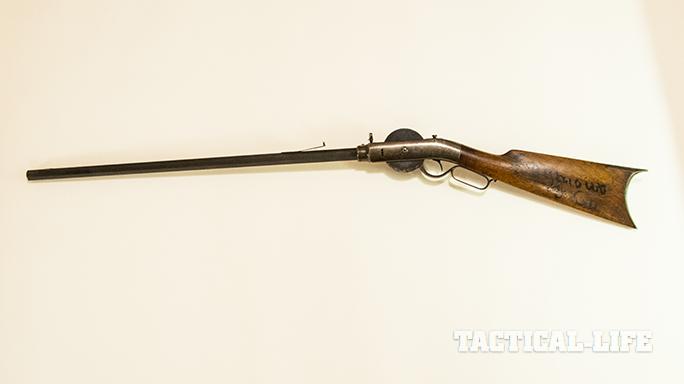The first ironclad warship commissioned by the United States Navy, the USS Monitor, proved the effectiveness of a rotating turret. The turret was a concept unique in design, one that had never even been tested by any navy prior to its use on the Monitor, and yet this simple concept changed the course of naval warship design. The turret was thus a game-changer for warships, yet the same thing can’t be said for small arms. In fact, several notable designs, including the Porter turret rifle, were based around a very similar concept for providing greater firepower to infantrymen.
At its core, the turret gun was nothing more than a variation on the percussion revolver cylinder designed by Samuel Colt. Yet in many ways it failed because it essentially tried to improve what already worked while avoiding Colt’s patent. The result was like trying to reinvent the wheel. Instead of offering an equally effective alternative for rapidly delivering rounds, the Porter turret rifle provided a solution that included a truly fatal flaw.
Not Quite Rolling
Let’s go back to understand the situation in which the Porter turret rifle came into being. First and foremost, in the years leading up to the Civil War, gun designers—not to mention inventors with little actual experience with firearms—sought to create a practical repeating rifle. Firearms design was moving forward thanks to recent innovations including interchangeable parts, and even the world of ammunition was changing.
Advertisement — Continue Reading Below
The first half of the 19th century saw a transition from smoothbore muskets to rifles. However, the big step forward in the pre-Civil-War era was the introduction of the percussion system, which meant that firearms could operate reliably in nearly any weather condition.
- RELATED STORY: Spec Ops History – Early Hot Air Balloons in the Civil War
One of the first designs to take advantage of what this offered was the 1837 Cochran rifle, which had several chambers encased in a turret that was mounted on its vertical axis much like the spokes of a wheel. This turret could hold up to eight shots. Without the need to reload after each round, this rifle was marketed to buffalo hunters and early frontiersman as a way to take down more game.
The design was not without a significant flaw, however. The location of the turret meant that some of the loaded chambers would point towards the face of the user, creating a situation that would be extremely dangerous given the likelihood of an accidental discharge. Due to this flaw, the Cochran rifle never saw widespread use. However, despite this, its fatal flaw was apparently forgotten all too quickly, as other designers utilized rotating turrets in their own concepts.
Advertisement — Continue Reading Below
Problematic Porter Turret Rifle
The most famous—or perhaps infamous—of these oddities was the Porter turret rifle, which was designed by T.P Porter in 1851. This rifle had an almost elegant look with a cocking lever that was reminiscent of the later Winchester repeating rifles. The Porter turret rifle featured a nine-shot, .44-caliber, percussion-cap turret that also was fed from a radial magazine like the Cochran design.
The turret was rotated and locked by the lever, and in this regard the design was successful at least in how individually loaded chambers on the perimeter of the turret were ignited by a self-priming, side-hammer mechanism. That made the operation of the rifle smooth and reliable—at least in theory.
- RELATED STORY: Inland’s Advisor M1 Pistol Is a Solid Piece of WWII History
As the chambers opened in all directions, it also meant that one chamber would be pointed at the shooter’s face—just like the Cochran rifle. More ominous was the fact that, due to the proximity of the respective chambers, there was a good chance of a row ignition or “chain fire.” This would result in all of the rounds firing in sequence, creating an all-too-fatal accident. This could kill the operator as well as anyone standing next to the shooter as bullets could literally fire in a 360-degree arc from the turret.
Advertisement — Continue Reading Below
It certainly wasn’t a good weapon for armies that tended to line up in formation during a battle, because who needs an enemy if only a couple of your rifles misfire and send bullets in every direction?
Somehow, despite a flaw that should have been seen as a deal-breaker at least, it was one of the few turret rifles to be put into serial production. Porter was able to contract out the rifle in three variations, with a total of some 1,250 rifles being produced in the 1850s. It is worth noting that 300 of first-generation Porter turret rifles were produced by G.P. Foster in Taunton, Massachusetts. According to several sources, the second and third versions were produced in facilities in New York City. As both Union and Confederate military planners sought superior firepower, the Porter turret rifle was one of those weapons that came under review.
Killer Rumor
However, the Porter turret rifle saw only limited use in the Civil War. As much as its design flaws, marketing actually played a factor. Even before the outbreak of the war, Samuel Colt, ever the savvy businessman, is reported to have started a rumor that his upstart rival T.P. Porter was killed by one of his own Porter turret rifles during a live-fire demonstration. Clever, eh?
Advertisement — Continue Reading Below
In truth, there is no evidence that any users were ever killed, but that fact, along with the rumors that were picked up by a number of newspapers, was enough to essentially kill the Porter turret rifle.
It remains a curiosity today among firearms enthusiasts for its craftsmanship and unique design, even if that design proved to have the potential to be deadly. In the end, Porter continued to design firearms—none as dangerous or flawed as the turret rifle, but never as successful as anything produced by Colt, either.
However, Porter might be happy to know that his badly conceived firearm is sought after by collectors—most of whom hopefully know better than to load all of the chambers when firing it. A fully functional Porter turret rifle in good condition can fetch up to $4,000 today. That’s not bad for a rifle that is all too likely to be found on a list of worst firearms designs of all time.
Advertisement — Continue Reading Below
This article was originally published in “Guns of the Old West” Fall 2017. To subscribe and order a copy, visit outdoorgroupstore.com.



































